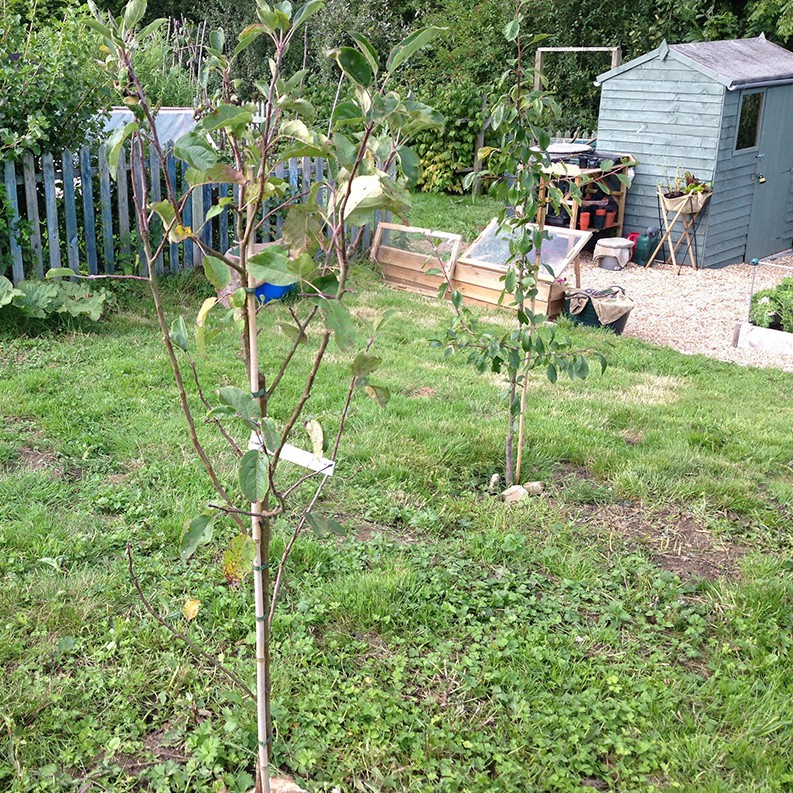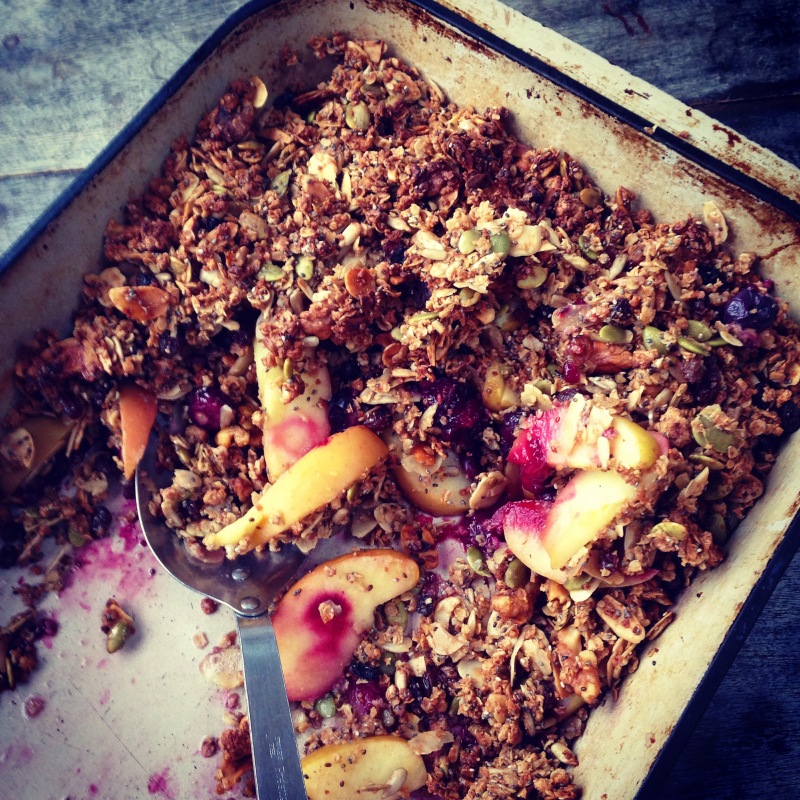Well here goes! This is the first of 26 ‘A-Z’ posts about the fruit, veg and flowers that we love to grow and eat on our allotment. Planting tips, growing guides, natural remedies, health benefits and tasty recipes, always with organic principles at heart and a biodynamic twist!
‘A’ is for apple! Hooray…
From early-autumn onwards our local organic farm shop is overflowing with freshly picked apples. These are of course delicious, but we really wanted to try growing our own, so in 2014 we planted a mini-orchard on our allotment.
Our children got to choose a variety of fruit tree to plant – Scarlet chose a ‘Scrumptious’ red apple, Tommy chose a ‘Limelight’ green apple and Stanley chose a ‘Victoria’ plum. We went for smaller varieties grown on ‘dwarf’ rootstocks that would eventually reach around 3m in height. Some apple trees are non-pollinating or self-sterile, which means they need another apple tree nearby to aid pollination of the fruit buds. In reality this is rarely an issue, as there are usually enough crab, domestic and wild trees around to pollinate your tree. Or buy two!

Planting: Apple trees like a sunny, weed free spot that is protected from the wind and are best planted in late-autumn to early-spring when the tree is dormant. Our trees came in large pots, so we needed to dig big holes to accommodate the root balls. We carefully placed the trees in the holes and backfilled with some compost until the soil and root ball were level. A little bit of gentle stamping down around the roots, a bucketful of water and away you go…
Growing: Keep apple trees moist, but not wet, throughout their first summer. Your tree will benefit from an annual 5cm compost mulch around the trunk. We don’t need to prune our trees yet, but in late-winter next year we’ll remove any damaged branches and possibly cut back a few of the older ones.

Harvesting: Your apples should be ready to harvest 14-20 weeks after flowering, usually from mid-summer to late-autumn. Our first apple harvest was beyond exciting and these little apples tasted doubly amazing because we had grown them ourselves! We picked some blackberries on the way home and indulged in homemade and homegrown apple and blackberry crumble…
Biodynamic Tips: To make use of these tips you’ll need a biodynamic or lunar gardening calendar. More information about biodynamic gardening can be found here.
- All work is carried out on ‘fruit’ days.
- Plant and prune your tree when the moon is descending to encourage fantastically strong roots.
- Harvest your apples when the moon is ascending. They’ll taste better and last longer.
- Spray CPP on the soil and trunk to protect against fungal diseases.
Natural Remedies: Nettle tea is a fantastic natural remedy to help ward off those pesky fungal diseases and make your apples less attractive to pests. Wild flowers planted nearby will attract beneficial insects and aid pollination if you have a non-pollinating variety of apple tree.

Health Benefits: Apples are massively high in vitamin C as well as a whole host of other important vitamins and minerals. Known to have anti-inflammatory and cholesterol-reducing properties, apples are also super-high in fibre which keeps you feeling fuller for longer. I love apples!
Recipes: There’s nothing quite like a freshly picked apple. Crisp, juicy and full of flavour, delicious raw, but equally tasty cooked. Here are some of our homegrown recipes for you to try…
- Apple & Berry Crumble
- Apple & Cardamom Porridge
- Green Tomato Chutney
- Sunshine Juice
- Allotment Juice
- Avocado Smoothie
Apple Trees
- Variety Scrumptious & Limelight on dwarf rootstocks
- Plant Late-autumn to early-spring when the tree is dormant. 6-12 ft apart
- Grow Benefits from an annual compost mulch. Prune in late-winter.
- Harvest 14-20 weeks after flowering, usually mid-summer to late-autumn
- Biodynamic tips All work is carried out on ‘fruit’ days. Plant & prune when the moon is descending. Harvest when the moon is ascending. Spray CPP on the soil and trunk to protect against fungal diseases.
- Natural remedies Nettle tea wards off fungal diseases and makes your apples less attractive to pests. Wild flowers planted nearby will attract beneficial insects and aid pollination.
Planting guide by Homegrown Kate www.homegrownkate.com


I LOVE this blog! Now I want to go straight out and plant an apple tree ‘cos I know how thanks to you😀🌳🍎💛
LikeLike
This is absolutely awesome! What a great idea. The A-Z of living off your allotment. I’ve learned so much about apples in the last 10 minutes. Extraordinary 🙏🏻 and as always beautifully written. Right, time for a glass of cider I think 🍻 Magic. Can’t wait now. The suspense! What’s B going to be for!!!!!
LikeLiked by 1 person
Brlilliant. i love the way you write.
LikeLiked by 1 person
Blimey! Well done – reads beautifully and full of fascinating information. xxx
LikeLiked by 1 person